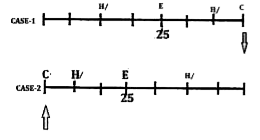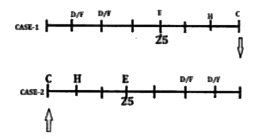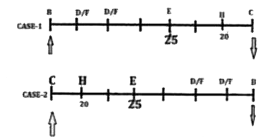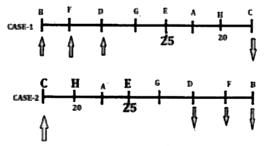Study the information given below and answer the given questions.
Eight persons A, B, C, D, E, F, G, H are sitting in a row. Four of them are facing north while four of them are facing south. No two persons according to alphabetical order are sitting together (for ex- A can't sit near to B and B can't sit near to A & Cand so on). Also each of them is of different age. E sits third to the right of C and his age is a square of 5. C sits at one of the extreme end of the row. Only one person sit between E and H. H's age is 4/5th of the age of E. F sits to the immediate left of D and also faces same direction as D. B is not an immediate neighbour of E and faces opposite direction as C. Neither D nor F sits at an extreme end. Both Gand E are facing same direction to each other but opposite direction to B. A sits to the left of H but H does not face North. A faces same direction as E.
How many persons are sitting between G and C?
One
Two
Three
Four
The correct Answer is:C
E sits third to the right of C and his age is a square of 5. C sits at one of the extreme end of the row. Only one person sit between E and H.

Neither D nor sits at an extreme end. F sits to the immediate left of D and also faces same direction as D. From the given condition we get that H is an immediate neighbour of C.

H.s age is 4/5th of the age of E. B is not an immediate neighbour of E and faces opposite direction as C. So, clearly B sits at the other end and faces opposite direction of C.

Now, we know that the only place left for G is between E and D. and Fwill sit to the immediate right of B.F sits to the immediate left of D-and also faces same direction as D. So, F and D face North direction in case-1 and face South in case-2. Rest A sits in between H and E.

A sits to the left of H but H does not face North. So, from this case-1 will be eliminated. Now Both G and E are facing same direction to each other but opposite direction to B. A faces same direction as E. So, the final arrangement is---

Similar Questions
दो सेलो के मानक विधुत वाहक बल नीचे दिए गये है ।
2Ag+Pt2+→2Ag++Pt, E∘=0.40V
2Ag+F2→2Ag++2F−, E∘=2.07V
यदि सेल अभिक्रिया Pt→Pt2++2e का मानक विभव 0 मान लिया जाए तो ज्ञात करो ।
(i) 1Ag→Ag++e− के लिए मानक विभव ,
(ii) F−→12F2+e के लिए मानक विभव13:30View Solutionयदि A और B दो घटनाएँ इस तरह से हों कि P(A)=13,P(B)=14,P(A∩B)=15 तो P(A/B)=
01:10View Solutionनिम्नलिखित कथनों पर विचार करें :
कथन I : यदि A और B प्रतिदर्श समष्टि S के संगत दो घटनाएँ ऐसा है कि P(A)=0.2 और P((B)=0⋅8 तो A⋃B एक सुनिश्चित घटना है |
कथन I : यदि A और B परस्पर अपवर्ती हों तो P(A)+P(B)=1 इन कथनो में :View Solutionयदि A और B दो स्वतंत्र घटनाएँ हो तो
03:06View Solutionयदि A तथा B दो स्वतंत्र घटनाएँ हों, तो सिद्ध करें कि P(A∪B)=1−P(A')P.(B')
02:12View Solutionयदि f(x) एक बहुपद है जबकि f(a)f(b)<0, तो a तथा b के बीच शुन्यकों की संख्या क्या होगी ?
02:49View Solutionयदि f(x)=ax2+bx+c के कोई वास्तविक शून्यक नहीं है a+b+c<0 है , तो
03:02View Solutionयदि (secA+tanA)(secB+tanB)(secC+tanC)
=(secA−tanA)(secB−tanB)(secC−tanC) हो, तो सिद्ध करो की प्रत्येक पक्ष ±1के बराबर है।04:55View Solution
